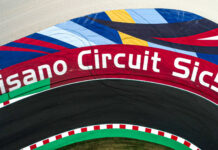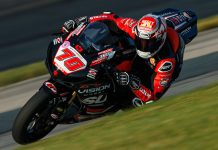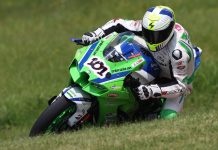If you had a blank check, no set deadline for completion, 750 acres of land, and the blessing of local and state authorities to build the finest road racing course in the world, what would your track be like?
In essence, that is the situation that faced officials with the Barber Motorcycle Museum a little over two years ago, when wealthy motorcycle enthusiast, collector, race team owner and museum owner George Barber tasked them with building a new racetrack and museum complex in Birmingham, Alabama. Now, as the warmer, drier weather of spring arrives, the $33 million Barber Motorsports Park is nearing completion. When will it open?
“It’ll be done when it’s done, and it’ll be right when it’s done,” says Track Manager Lee Clark. “That’s frustrating to some folks because they want to come see it, but Mr. Barber wants to make sure it’s done right. Our main focus is getting it built. We’re lucky in that it’s not like we’re forced to open it at an early date to generate income to satisfy a lender or something. Mr. Barber wants it right, and if that means it sits here an extra four or five months getting it right, then that’s what he wants. It’s hard to beat a bad first impression. We want to have a premier place, and that’s just the way he likes to do it.
“We started off with a little $3 million test track and now it’s gone to the international level. We have a lot of help financially. The city of Birmingham is leasing us the land for a $1 a year for 90 years. The Governor (of Alabama) gave us $2.5 million for the access road. It’s going to be a four-lane divided highway. One of the things that we feel fortunate about is that we have the full support of the city, the county, and the state. Normally with tracks, everybody doesn’t want them. We have the full support because they realize the high profile that motorsports can be if it’s done correctly and the economic development of it. Birmingham and Alabama have done a pretty good job of attracting the Honda, the Mercedes, and the Toyota plants. They understand that motorsports is a viable part of that. The down side of that is that every time you add another player, it tends to slow things down a little bit. But it’s not bad.
“We’ve pretty much got the major portion of the earth work done. We moved 1.4 million cubic yards of dirt. The first layer of asphalt is down. We decided to wait until spring time to put the last two inches, called the ‘Wear Course,’ on because it’s a polymer base… we are going to do that in a continuous paving so that there will not be any cold seams except for where they start and stop. So it will have one cold seam probably at start-finish on the front straightaway. We’re not worried about that, but there won’t be any longitudinal seams on the track because they are going to stagger the pavers and actually roll it all into one. We’re spending a lot of time and effort into making it one of the nicest surfaces around. It’s polymer with a mill slag, which is supposed to be some of the best in grip versus tire wear versus wet-weather adhesion.
“Anyway, we’ve got that to do still. It’s got to be 50 degrees Fahrenheit and rising. So obviously we’re going to wait and make sure that we don’t have a cold snap while we’re doing it because it’s going to take almost two full days to lay the surface non-stop. The track’s going to be 45 feet wide, the current level of FIA/FIM spec for the highest level of competition. Not that we expect to have a Formula One race but we figured those safety requirements will filter down into other areas somewhere in the future. So why not do it now?
“We had Claude Danis from the FIM here. He was very happy with what he saw. Of course he’s going to do another final inspection when the surface is down and all of the safety features are in. We don’t have guard railing yet. That’s one of the last things to go in. Franco Unchini (the 1982 500cc Grand Prix World Champion who now serves as IRTA’s safety representative) came with Claude Danis. Both of them said that we should have the best road course in the world. We’re really happy with that unsolicited endorsement because they go to the best tracks all around the world. We jokingly asked them where we needed the Air Fence. Claude said that we could have it in the paddock if we needed it there.
“(AMA Superbike Operations Manager) Ron Barrick has been here and liked what he saw. He was going to come with Claude the first time but had a conflict. But he said obviously that if Claude was happy, he was going to be happy because Ron is a member of the FIM, too. Then we had two of the riders (Barrick) brought over, Mike Smith and Dave Sadowski, to look at it not long ago. They were very happy with what they saw.
“It’s gonna be a fast track. Sure, you say it’s got 14 – 15 turns in 2.3 miles, but there’s only two tight turns, that little hairpin and a kind of a corkscrew. The rest of them are sweepers. They’re pretty fast. Some are downhill and banked. They’re all according to FIA/FIM spec. There are three major elevation changes in the 30-50 foot range through a turn or a series of turns.
“It’s a fun track. Unchini said, ‘This is road racing.’ He said it reminded him of some of the European tracks. The front straight is about 1400 feet long, then the back straight has a kink in it and is 2800 feet long. The elevation changes are in the last set of turns, the first set of turns, and the quasi-corkscrew.
“One of Mr. Barber’s main concerns is that we have a safe track. There’s a tunnel so that the ambulance workers don’t ever have to cross the track. That’s part of the FIM requirements. That’s one of those, if it’s gonna be safe for the FIM, it’s probably gonna be safe for everybody else. One of the odd things about the FIM is that they require guardrail all of the way around the track. It’s far enough back and not in the run-off zones, but they don’t want the ambulance to ever get hit. They hold new tracks to higher standards, of course. Now, the ambulance can never get on the track. For new tracks starting from a clean sheet, they want to use what we’ve learned in recent years. So we had to make some changes to do that. We spent about $130,000 for ambulance access. But that will make it a safer track, so we’re glad to do it. We actually didn’t have the guardrail in a lot of places, but they said, ‘You gotta have it here and here.’ But there again, it’s not very close to the track. One of the neat things about our gravel traps, we didn’t put them up close to the edge of the track like is currently being done. We put them about five meters back so that if you’re off a little bit, if you’re just barely out of whack, you’ve got a little bit of time to straighten up. Then you’ve got the gravel, then you’ve got more earth or grass, then you’ve got the tire wall. I don’t think that many motorcycles are ever gonna make all of the way through the gravel traps unless they try to ride through it, and that’s up to them. I think the $400,000 worth of gravel traps are going to do their job.
“There’s a lot of speculation about the first big events we will have, but Mr. Barber wants us to focus on getting it built right now. Nothing is confirmed. We’ve talked to a lot of folks so if it does happen, we won’t have to re-design the whole thing. It would be stupid to not take that into account. We don’t have any tentative dates for opening or a first event. We don’t want to promise something and not be able to deliver unless we’re 100 percent. Most likely, 2001 if we have anything, it will be some club stuff and driving schools just to get our feet wet and get the infrastructure together. In 2002 we will hit the ground running.
“Our track designer, Alan Wilson, has done Kershaw (Carolina Motorsports Park), Gingerman (Raceway), Pike’s Peak (International Raceway), the infield for Las Vegas, and he’s the chief safety guy in the SCCA Trans Am series. We’ve tried to seek out, in the different disciplines of construction, folks that have an interest in motorsports. It seems like you get a lot more out of them. (Racer) Bill St. John, who I’m sure you’re familiar with, was our civil engineer on the project. So we’ve had people checking people checking people. All of them want to see a good surface. Basically we’ve gone the extra mile. When they were doing the earth work, they have to get the compaction down to like 98.9 percent. And Bill’s guys are back there with a nuclear meter checking it every two feet of fill so we don’t have a settling problem. That’s how they do highways.
“The bed of the track is 10 inches of crushed stone. Your average road only has 6-8 inches, but we put 10 inches down. It has a compaction factor of 101 percent. It’s fully compacted. The quality control is the key there. Basically, it gives us a bed that you could race fully-loaded tractor-trailers on, not that we will, but you won’t have the settling. Then on top of that, we primed and put down the first two inches of asphalt that they call a binder. Then we let that set all winter, figuring that if we have any drainage problems they will show up. So if we discover that we need to put a drain on the edge of the track, we have the chance to put those in and fix ’em. So we basically have six-to- eight months of Mother Nature on it before we put the wear course on, which is the next two inches.
“Like anything, we have an evolution in mind as far as our infrastructure goes. We’re not going to build 1200 feet of garages on day one. Alan’s thought on that is to build as few buildings as possible so that you can grow into it when you see what works. We have a full build-out that’s going to have bathrooms and stuff. Initially, I don’t see that we will ever have any need for stadium seating. We’ve got beautiful, natural grades with sod on it. We can seat 30,000 people on these hills. From one 1600 foot section of hillside, you can see at least half, if not three-quarters, of the track. From two of the other areas of natural amphitheater seating, you can see over half the track. Even the 17-acre paved paddock is terraced. So if we only put buildings down at one end, people working in the paddock will be able to see the track. We really think that’s going to be a plus. I’ve always been more of a spectator/mechanic in racing all my days. That was my hope that we would make it spectator-friendly. I think road racing in America suffers because you can only see one or two turns. And if you can, you don’t get to see much passing going on. Our first priority was safety. Our second was to put our overtaking zones in spectator areas. I think it’s worked out that way just with the width. Being 45 feet wide, there’s going to be multiple lines around the track, and Smith and Sadowski confirmed that.”
Though he wouldn’t send Roadracing World a track layout map, Clark did point out that workers have begun to plant flowerbeds everywhere because track officials want the track to look like “a golf course with a 180 mph cart path through it. We want to be the Augusta of racetracks.”
Insiders say that the new Barber Motorsports Park will host a U.S. GP in 2002.











